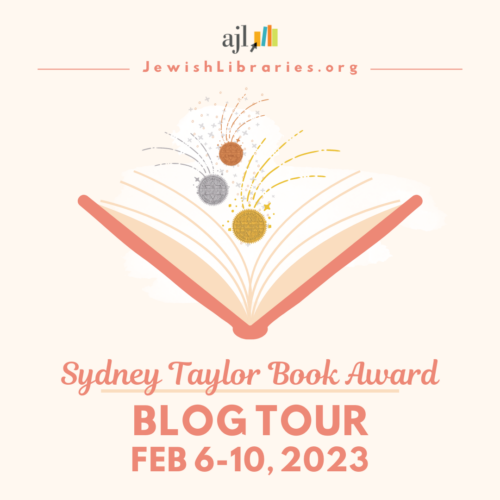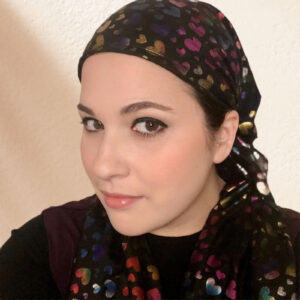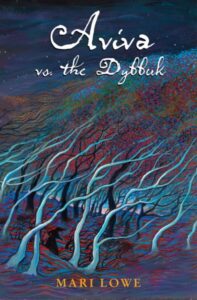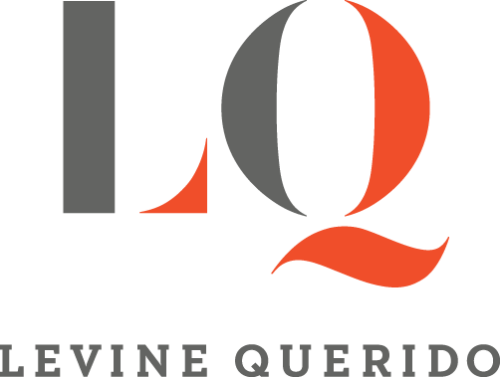Sydney Taylor Book Blog Award Tour Interview: Featuring Mari Lowe of Aviva Vs. the Dybbuk!

I am so pleased and honored to bring to you today a post as part of the Sydney Taylor Book Award Blog Tour of 2023. And to make matters even better, the person that I was allowed to host today is none other than the fantastic, amazing, one-of-a-kind, singular Mari Lowe.
Remember back in April of 2022 when I reviewed the remarkable middle grade novel Aviva Vs. the Dybbuk? Do you remember how I said it was one of the best books of the year? How it should win ALL the things? Welp, I am pleased to announce that it did happen to win something. A little something by the name of the Sydney Taylor Book Award Gold Medal. The Sydney Taylor Book Award, by the way, is, “presented annually to outstanding books for children and teens that authentically portray the Jewish experience. Presented by the Association of Jewish Libraries since 1968, the award encourages the publication and widespread use of quality Judaic literature. Gold medals are presented in three categories: Picture Books, Middle Grade, and Young Adult. Honor Books are awarded silver medals, and Notable Books are named in each category. A Body-of-Work Award is given periodically for significant contributions to the genre of Jewish children’s literature.”
ADVERTISEMENT
ADVERTISEMENT
I loved this book. Truly. And now I get to ask Mari Lowe herself about it. Enjoy!!
Betsy Bird: Mari! Many thanks for joining me here today. Before we get into anything else, I’m going to be gauche and ask you the question that people love to know most: How did you discover that Aviva Vs. the Dybbuk won the Sydney Taylor Book Award Gold Medal? Where were you when you got the proverbial call?

Mari Lowe: I had known that it would be submitted for consideration, but this is my first rodeo! I didn’t know the award recipients were notified in advance, so I didn’t second-guess anything when my publisher suggested a Zoom meeting for a book that wasn’t due to come out until the fall. I locked myself in my sons’ room for the meeting, very casual (a mess! drawers open behind me with shirt sleeves coming out!), and there were many more faces on the screen than I’d expected. I thought, wow, they’re really going all out with publicity this time, and then everyone started speaking and it began to sink in.
Kidding! It still didn’t sink in. I didn’t quite understand that I’d won until Antonio Cerna wrote YOU ARE A MEDALIST!! in the chat. And at the end of the meeting, I still had no idea if we were also supposed to talk about the other book! I sat there for five minutes, processing and waiting just in case I was supposed to be on Zoom again, and then I went downstairs to be absolutely insufferable for the next week.
BB: Deservedly insufferable, though! I loved watching your tweets during the ALA YMA announcements. At one point you wrote, “LQ is OWNING jewish lit right now.” For folks that don’t know, that’s a reference to your publisher Levine Querido. With that in mind, I have to ask, how did you come to write the book and how did it end up getting published with LQ?
ML: I live in an interesting kind of world, where we are kind of bubbled up in our own culture, but there’s plenty of exposure to the world around us. (Not the same for all Orthodox Jews! I have two sisters who are strictly enmeshed solely in our culture– one has never forgiven me for the week one summer, thirteen years ago, when I got her hooked on Veronica Mars and she watched her first ever TV show.) So plenty of us see when we’re in the media, and we’re always very excited about it. Except, of course, that nearly every portrayal of Orthodox Judaism out there is either negative or othering.
And I don’t want to downplay individuals’ true stories! Those are authentic and my heart goes out to each of them. But there is this greed in the media for Orthodox suffering, for stories about how we are strange and backward and different, for stories about fleeing from Orthodoxy and finding freedom outside of it. There is so little space for Orthodox Jewish joy! And I have my quibbles with my community, as every person will, but I have known so much joy within it, too. So I guess my initial focus was really just on writing something about a child existing within Orthodox Judaism where the story wasn’t her culture but her.
When I started it, I had no idea if there would be a market for it or any interest at all. And honestly, I don’t know if I would have found any outside of Levine Querido. I’ve heard a lot of advice from some other publishers about Jewish books– reminders to tone down the Jewish aspect, to make it accessible above all else, and I have seen many other books where you can almost taste the compromises that had to be made in the process. It’s not every publisher, and I do understand the perspective! This is a field where books have to sell to be worthwhile, and there’s a risk in taking a story and prioritizing authenticity over marketability.
Irene Vázquez from Levine Querido plucked my story from the slush pile and passed it to Arthur Levine right around when I was running out of hope (do you think there’s a chance it’ll ever find a home or should we start work on something new? I asked my agent, just a month before Arthur’s email) and I was astounded at his commitment both to the story and to its authenticity. I have seen, again and again, when it comes to various cultures and experiences, a focus from LQ on marginalized voices that might otherwise be overlooked, and I was so fortunate to find my way to them.
Long answer! Lots of feelings.
BB: As you’ve mentioned, finding the Orthodox Jewish community portrayed in anything but a stereotypical way in our books and television can be hard. Finding the community in children’s literature at all is almost impossible. I wonder if you could talk a bit about how you chose to portray the characters in this book, and what you hope your young readers will take away from the reading experience.

ML: My answers to this question and the one above it really overlap, but my portrayal was very much about existing while Orthodox. The story is not Orthodoxy– and I don’t know if I would ever be very interested in writing about that– but it is a backdrop to a story that I hope is universal, a setting far less alien to readers than a magical kingdom full of fantastical creatures. I felt that if readers can read a book and learn a dozen new terms that only exist in one particular fictional universe, why not terms that are used in real communities throughout the world?
My main focus, therefore, was writing a story that was universal. I was invested in portraying many of the best parts of my culture– the endless well of community support for the needy, the female role models that girls are surrounded by throughout childhood, the joy that is sparked by communal Bas Mitzvah celebrations– but I don’t think that any of those are unique to my culture. I wanted to write stories that anyone could relate to while demystifying Orthodox Judaism to young readers. Middle graders, I think, are at the age when they’re ready to explore unfamiliar worlds, but they have not yet learned much of the prejudice that can come with time. It’s a rare, lovely age when readers just want to know, and I hope that I’ve given them some insight and empathy with Aviva.
BB: The mix of supernatural and intensely realistic is exquisitely well done in the book. But finding that balance couldn’t have been easy. When you were going through the writing and the editing, how much of the final book was present in the first draft? Did the book change much or was it pretty much as is from the beginning?
ML: Thank you! It’s a relief to hear. It’s funny, because sometimes I see people characterize it as contemporary and sometimes as fantasy, and it exists a bit in the space between both. I incline more toward writing fantasy, normally, but this book felt as though it had to be contemporary to achieve what I wanted it to when it came to Jewish culture. (The next book is contemporary as well, but the one I’m working on now has veered to speculative fantasy that is also contemporary…ish? Genre eludes me.)
When I began the story, it was far more bare-bones than it is now– the basic story was there, but I was afraid to let it become too intense, worried it might cross lines in middle grade. Needless to say, I had to read a lot more middle grade before I understood that the line was nowhere near where I thought it might be. After that, I was able to delve into the mental health aspects of it as much as I wanted to, and it made for a much stronger book.
BB: Since you were writing about a dybbuk (not much of a spoiler, since it’s in the name and all) were there aspects of it that you purposefully avoided? For that matter, did you have any ideas for the book that later had to be scrapped for one reason or another?

ML: Oh, definitely. The original stories of dybbuks, while excellent at keeping me up at night, are based on legends that seem to be inspired by people with schizophrenia or other conditions that the people of the time didn’t understand. And that wasn’t a story I wanted to tell. What really intrigued me about the legend of the dybbuk was the concept of this maybe-malicious creature with unfinished business in this world, lingering behind and waiting for actualization. It felt so reminiscent Aviva and her mother, who begin the story still trapped in the past, unable to move forward without resolving their own emotions and reactions. A dybbuk is all about those liminal moments, and it was the apropos manifestation of what Aviva and her mother were enduring.
Originally, I imagined the book as a lighthearted series of stories about Aviva derailing the dybbuk’s schemes in various situations. But within a chapter or two of writing, it became clear that this was a family who was suffering, and a story that should reflect and work with that. The dybbuk would be a pain for Aviva, but it was also an anchor for her in a life where she was floundering, and the initial plan for a silly little story became something much deeper.
BB: The book’s been out for a little while now. Have you gotten any interesting responses from kids? Either as readers of the book or the ones you’ve spoken to about the book.
ADVERTISEMENT
ADVERTISEMENT
ML: I have gotten some adorable postcards from kids who aren’t my children and some strong criticism from a kid who is my child (who did not like the final twist and isn’t shy about it). The most delightful thing, though, is the bafflement from Orthodox Jewish kids when they read or hear about the book. “You wrote about a frum (Orthodox) girl? For non-frum people to read, too? Why?” It’s such an unfamiliar concept for them, one that I’d have shared at their age, and I hope that it becomes something more common as the book world continues to include historically underrepresented groups!
BB: Finally, the most difficult question of them all: What do you have coming out next?
I am so happy to answer this! I have another book (title pending) set in my community coming out with Levine Querido this fall about my absolute favorite topic, as a middle school teacher: girls behaving very, very badly. (But wait! you might ask. What happened to positive representation? to which I say that sometimes that story is about letting middle school girls be monsters to each other, as middle schoolers can do. Ah, representation!) It centers around a girl named Shaindy, the overlooked outcast in a class of model students, and what happens when she secretly teams up with the class leader for a series of pranks. What can rage make us do? And how do we come back from the unforgivable?
I am also working on another book right now– that aforementioned many-genre story. It’s set in a city where accidental murderers are allowed to live in peace, provided that they never leave. The main character is a boy who helps maintain the city. When someone starts targeting the most dubious of the accidental murderers, our hero is forced to tackle his own past misdeeds to catch the villain. There’s a lot of contemplation of justice and punishment and what is deserved, and I’m very excited to hopefully get it out there someday!
Loads of thanks to Mari for taking the time to answer my questions and to Talya Sokoll and everyone involved with the Sydney Taylor Book Award for allowing me this chance to speak with Mari. The blog tour continues all this week (schedule here) and here’s what they’ll have coming up:
MONDAY, FEBRUARY 6, 2023
Chana Stiefel and Susan Gal, author and illustrator of The Tower of Life
Sydney Taylor Book Award in the Picture Book Category
at 100 Scope Notes at School Library Journal
Mari Lowe, author of Aviva vs. the Dybbuk
Sydney Taylor Book Award in the Middle Grade Category
at A Fuse #8 Production at School Library Journal
Sacha Lamb, author of When the Angels Left the Old Country
Sydney Taylor Book Award in the Young Adult Category
at Out of the Box at The Horn Book
TUESDAY, FEBRUARY 7, 2023
Erin Silver, author of Sitting Shiva
Sydney Taylor Honor Book in the Picture Book Category
at Jewish Books for Kids…And More!
Sarah Darer Littman, author of Some Kind of Hate
Sydney Taylor Honor Book in the Young Adult Category
at Good Reads with Ronna
WEDNESDAY, FEBRUARY 8, 2023
Paul Martin, widower of Paula Cohen Martin, author of Big Dreams, Small Fish
Sydney Taylor Honor Book in the Picture Book Category
at Picture Books Help Kids Soar
Shoshana Nambi and Moran Yogev, author and illustrator of The Very Best Sukkah
Sydney Taylor Honor Book in the Picture Book Category
at Pragmatic Mom
Meira Drazin, author of Honey and Me
Sydney Taylor Honor Book in the Middle Grade Category
at The Whole Megillah
Hannah Reynolds, author of Eight Nights of Flirting
Sydney Taylor Honor Book in the Young Adult Category
at Watch.Connect.Read
THURSDAY, FEBRUARY 9, 2023
Sofiya Pasternack, author of Black Bird, Blue Road
Sydney Taylor Honor Book in the Middle Grade Category
at From the Mixed Up Files of Middle Grade Authors
A.J. Sass, author of Ellen Outside the Lines
Sydney Taylor Honor Book in the Middle Grade Category
at Bookishly Jewish
Jennieke Cohen, author of My Fine Fellow
Sydney Taylor Honor Book in the Young Adult Category
at Paper Brigade Daily at The Jewish Book Council
FRIDAY, FEBRUARY 10, 2023
Blog Tour Wrap-Up at The Children’s Book Podcast
Filed under: Uncategorized
About Betsy Bird
Betsy Bird is currently the Collection Development Manager of the Evanston Public Library system and a former Materials Specialist for New York Public Library. She has served on Newbery, written for Horn Book, and has done other lovely little things that she'd love to tell you about but that she's sure you'd find more interesting to hear of in person. Her opinions are her own and do not reflect those of EPL, SLJ, or any of the other acronyms you might be able to name. Follow her on Twitter: @fuseeight.
ADVERTISEMENT
ADVERTISEMENT
SLJ Blog Network
Name That LEGO Book Cover! (#53)
Exclusive: Vol. 2 of The Weirn Books Is Coming in October | News
Fighting Public School Book Bans with the Civil Rights Act
Take Five: Middle Grade Anthologies and Short Story Collections
ADVERTISEMENT








Fantastic interview! The book was my favorite middle grade book of 2022 and when I read it shortly after it was released, I also thought it should win ALL the things! I can’t wait to read more by this author.